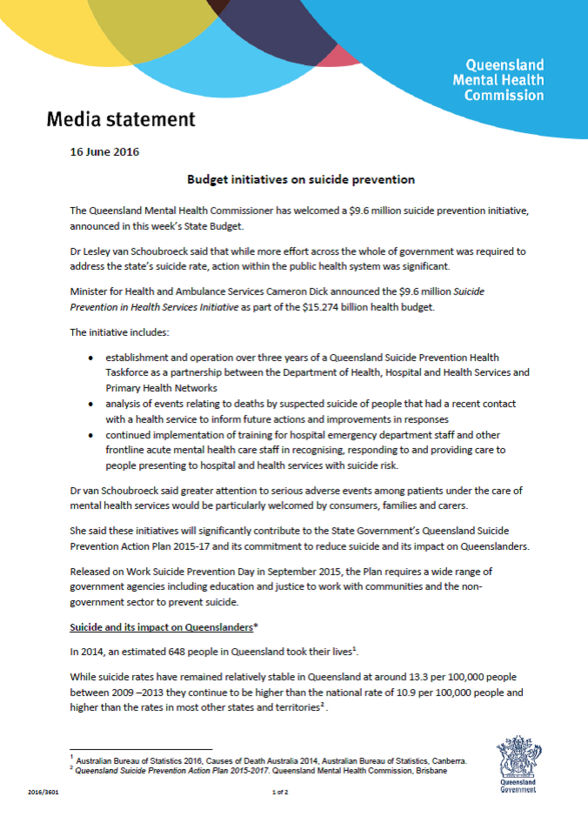The Queensland Mental Health Commissioner has welcomed a $9.6 million suicide prevention initiative, announced in this week’s State Budget.
Dr Lesley van Schoubroeck said that while more effort across the whole of government was required to address the state’s suicide rate, action within the public health system was significant.
Minister for Health and Ambulance Services Cameron Dick announced the $9.6 million Suicide Prevention in Health Services Initiative as part of the $15.274 billion health budget.
The initiative includes:
- establishment and operation over three years of a Queensland Suicide Prevention Health Taskforce as a partnership between the Department of Health, Hospital and Health Services and Primary Health Networks
- analysis of events relating to deaths by suspected suicide of people that had a recent contact with a health service to inform future actions and improvements in responses
- continued implementation of training for hospital emergency department staff and other frontline acute mental health care staff in recognising, responding to and providing care to people presenting to hospital and health services with suicide risk.
Dr van Schoubroeck said greater attention to serious adverse events among patients under the care of mental health services would be particularly welcomed by consumers, families and carers.
She said these initiatives will significantly contribute to the State Government’s Queensland Suicide Prevention Action Plan 2015-17 and its commitment to reduce suicide and its impact on Queenslanders.
Released on World Suicide Prevention Day in September 2015, the Plan requires a wide range of government agencies including education and justice to work with communities and the non-government sector to prevent suicide.
Suicide and its impact on Queenslanders*
In 2014, an estimated 648 people in Queensland took their lives[1].
While suicide rates have remained relatively stable in Queensland at around 13.3 per 100,000 people between 2009 –2013 they continue to be higher than the national rate of 10.9 per 100,000 people and higher than the rates in most other states and territories[2].
According to the Australian Institute for Suicide Research and Prevention one third (31.2 per cent) of people who died by suicide in Queensland between 2002 and 2011 had previously attempted suicide[3].
For every person who dies by suicide, an estimated 30 people attempt suicide[4] with a higher proportion of women attempting suicide than men. Some groups experience higher rates of suicide including Aboriginal and Torres Strait Islander peoples; people living in rural and remote communities; people living with mental illness; children and young people known to the child protection system; people from culturally and linguistically diverse backgrounds and Lesbian, Gay, Bisexual, Transgender and Intersex people.
The impacts of suicide are immediate, far-reaching and long-lasting. They are felt by families, friends, work colleagues and the broader community, who may struggle to support a person experiencing suicidal behaviour or to cope with the aftermath of a suicide.
The number of people impacted by suicide is difficult to quantify, with one study finding that for every suicide six people identify as being bereaved by suicide.[5]
There are also significant impacts on service providers, particularly those providing support and treatment, and first responders such as police and ambulance services, who are required to respond to these types of incidents.
*(Extracted from Queensland Suicide Prevention Action Plan 2015-17)
[1] Australian Bureau of Statistics 2016, Causes of Death Australia 2014, Australian Bureau of Statistics, Canberra.
[2] Queensland Suicide Prevention Action Plan 2015-2017. Queensland Mental Health Commission, Brisbane
[3] Ibid
[4] Ibid
[5] Ibid
-
 Budget initiatives on suicide prevention (PDF, 273.9 KB)
Budget initiatives on suicide prevention (PDF, 273.9 KB)

